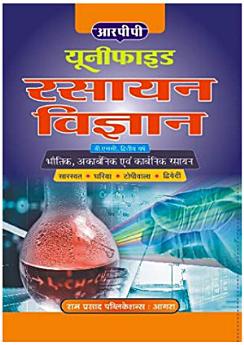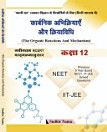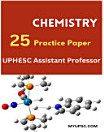CHEMISTRY-PHYSICAL, INORGANIC, ORGANIC-IN HINDI: PHYSICAL, INORGANIC, ORGANIC
About this ebook
Unit – I : (A) Thermodynamics : Basic concepts of thermodynamics.
First Law, Second Law of Thermodynamics : Need for the law, Different statements of the law, Carnot cycle and its efficiency. Carnot theorem. Thermodynamic scale of temperature.
Concept of Entropy : Entropy as a state function, entropy as a function of P & T and T & V, entropy change in physical change. Clausius inequality, entropy as criteria of spontaneity and equilibrium. Entropy change in ideal gases and mixing of gases. Nernst heat theorem, statement and concept of residual entropy, evaluation of absolute entropy from heat capacity data, Gibbs and Helmholtz functions, Gibbs function (G) and Helmholtz function (H) as a thermodynamic quantities, A and G as a criteria for thermodynamic equilibrium and spontaneity, their advantage over entropy change.
(B) Thermochemistry : Standard state, standard enthalpy of formation : Hess’s Law of heat summation and its application. Enthalpy of neutralization.
Unit – II : Phase Equilibrium
Statement and the Meaning of Terms : Phase, component and degree of freedom, thermodynamic derivation of Gibbs phase rule. One Component System : Water, CO2 and S system. Two component system : Solid-liquid equilibrium. Simple eutectic system : Bi-Cd, Pb-Ag systems. Desilverisation of lead.
Solid Solutions : Systems in which compound formation with congruent melting point (Zn-Mg) and incongruent melting point. (NaCI-H2O) and (CuSO4-H2O) system, Freezing mixtures : Acetone-dry ice.
Liquid-Liquid Mixtures : Ideal liquid mixtures, Raoult’s and Henry’s law. Non-ideal system, azeotropes. HCl-H2O and ethanol-water system.
Partial Miscible Liquids : Phenol-water, trimethylamine-water and nicotine-water system. Lower and upper consolute temperature. Immiscible liquids, steam distillation. Nernst distribution law : Thermodynamics derivation, applications.
Unit – III : Electrochemistry-I
Electrical Transport : Conduction in metals and in electrolyte solutions, specific and equivalent conductivity, measurement of equivalent conductance, effect of dilution on conductivity, migration of ions and Kohlrausch law, Arrhenius theory of electrolyte dissociation and its limitations. Weak and strong electrolytes, Ostwald’s dilution law, theory of strong electrolytes, DHO theory and equation, transport numbers, determination of transport numbers by Hittorf method and moving boundary method.
Unit – IV Electrochemistry-II
Types of Reversible Electrodes : Gas-metal ion, metal-metal ion, metal-insoluble salt-anion and redox electrodes. Electrode reactions, Nernst equation, derivation of cell E.M.F. and single electrode potential, standard hydrogen electrode, reference electrodes, standard electrode potential, electrochemical series and its significance.Electrolytic and Galvanic cells, reversible and irreversible cells, conventional representation of electrochemical cells.
Concentration cell with and without transport, liquid junction potential, application of concentration cells, valency of ions, solubility product and activity coefficient, potentiometric titration. Definition of pH and pK, determination of pH using hydrogen, quinhydrone and glass electrodes by potentiometric methods.
Buffers : Mechanism of buffer action, Henderson-Hazel equation, hydrolysis of salts.
Unit – V : Surface Chemistry
Adsorption, adsorption and absorption, types of adsorption, adsorption of gases and liquids in solid adsorbent, Freundlich and Langmuir adsorption isotherms, surface area and determination of surface area.
Catalysis : Characteristics of catalysed reactions, classification of catalysis, application of catalysts, miscellaneous examples.
Inorganic Chemistry
Unit–I : Chemistry of Elements of First Transition Series
Characteristic properties of d-block elements.
Properties of the elements of the first transition series, their binary compounds such as Carbides, Oxides and Sulphides.
Complexes illustrating relative stability of their oxidation states, co-ordination number and geometry.
Unit–II : Chemistry of Elements of Second and Third Transition Series
General characteristics, comparative treatment with their 3d-analogues in respect of ionic radii, oxidation states, magnetic behaviour, spectral properties and stereochemistry.
Unit–III : (A) Co-ordination Compounds
Werner's co-ordination theory and its experimental verification, effective atomic number concept, chelates, nomenclature of co-ordination compounds, isomerism in co-ordination compounds, valence bond theory of transition, metal complexes.
(B) Oxidation and Reduction
Use of redox potential data : Analysis of redox cycle, redox stability in water : Frost, latimer and Pourbaix diagrams. Principles involved in the extraction of elements.
Unit–IV : (A) Chemistry of Lanthanide Elements
Electronic structure, oxidation states, ionic radii and lanthanide contraction, complex formation, occurrence and isolation, lanthanide compounds.
(B) Chemistry of Actinides
General features and chemistry of actinides, chemistry of separation of Np, Pu, and Am from U, similarities between the later actinides and the later lanthanides.
Unit–V : (A) Acids and Bases
Arrhenius, Bronsted-Lowry, the Lux-Flood, solvent system and Lewis concepts of acids and bases.
(B) Non-aqueous Solvents
Physical properties of a solvent, types of solvents and their general characteristics, reactions in non-aqueous solvents with reference to liquid NH3 and liquid SO2.
Organic Chemistry
Unit–I : Electromagnetic Spectrum : Absorption Spectra
Ultraviolet (UV) absorption spectroscopy : Absorption laws (Beer-Lambert law), molar absorptivity, presentation and analysis of UV spectra, types of electronic transitions, effect of conjugation. Concept of chromophore and auxochrome. Bathochromic, hypsochromic, hyperchromic and hypochromic shifts. UV spectra of conjugated enes and enones. Infra red (IR) absorption spectroscopy : Molecular vibrations, Hooke’s law, selection rules, intensity and position of IR bands, measurement of IR spectrum, finger print region, characteristic absorption of various functional groups and interpretation of IR spectra of simple organic compounds.
Unit–II :
(A) Alcohols : Classification and nomenclature. Monohydric alcohols : Nomenclature, methods of formation of reduction of aldehydes, ketones, carboxylic acids and esters. Hydrogen bonding, acid nature and Reactions of alcohols.
Dihydric alcohols : Nomenclature, methods of formation, chemical reactions of vicinal glycols, oxidative cleavage [Pb (OAC)4 and HIO4] and pinacol-pinacolone rearrangement. Trihydric alcohols : Nomenclature, methods of formation, chemical reactions of glycerol.
(B) Phenols : Nomenclature, structure and bonding, Preparation of phenols, physical properties and acidic character, comparative acidic strengths of alcohols and phenols, resonance stabilization of phenoxide ion. Reactions of phenols : Electrophillic aromatic substitution, acylation and carboxylation. Mechanism of Fries rearrangement, Claisen rearrangement, Gatterman synthesis, Huaben-Hoesche reaction, Lederer-Manasse reaction and Reimer-Tiemann reaction.
Unit–III : Aldehydes and Ketones
Nomenclature and structure of the carbonyl group. Synthesis of aldehydes and ketones with particular reference to the synthesis of aldehydes from acid chlorides, synthesis of aldehydes and ketones using 1, 3-dithaines, synthesis of ketones from nitrilles and from carboxylic acids. Physical properties.
Mechanism of nucleophilic additions to carbonyl group with particular emphasis on benzoine, aldol, Perkin and Knoevenagel condensations. Condensation with ammonia and its derivatives. Wittig and Manich reaction.
Use of acetals as protecting groups, Oxidation of aldehydes, Baeyer-Villiger oxidation of ketones. Cannizzaro reaction. MPV, Clemmensen, Wolff Kischner, LiAlH4 and NaBH4 reductions. Halogenation of enolizable ketones. An introduction to alfa, beta unsaturated aldeyhydes and ketones.
Unit–IV : (A) Carboxylic Acids
Nomenclature, structure and bonding, physical properties, acidity of carboxylic acids, effects of substituents on acid strength. Preparation of carboxylic acids and reactions of carboxylic acids. Hell-Volhard-Zelinsky reaction. Synthesis of acid chlorides, esters and amides. Reduction of carboxylic acids. Mechanism of decarboxylation. Methods of formation and chemical reactions of halo acids, hydroxyl acids, malic, tartaric and citric acids. Methods of formation and chemical reactions of unsaturated monocarboxylic acids. Dicarboxylic acids : methods of formation and effect of heat and dehydrating agents.
(B) Ethers : Nomenclature of ethers and methods of their formation, physical properties and chemical reactions. Cleavage and auto oxidation, Ziesel’s method.
Unit–V : Organic Compounds of Nitrogen
Preparation of nitro-alkanes and nitro-arenes. Chemical reactions of nitro-alkanes. Mechanisms of nucleophilic substitution in nitro-arenes and their reductions in neutral acidic and alkaline media.
Halonitroarenes : Reactivity, structure and nomenclature of amines, physical properties, stereochemistry of amines, separation of a mixture of primary, secondary and tertiary amines. Structural features effecting basicity of amines. Amine salts as phase-transfer catalysts. Preparation of alkyl and aryl amines (reduction of nitro compounds, nitriles), reductive amination of aldehydic and ketonic compounds. Gabriel-Phthalamide reaction, Hoffman-Bromamide reaction. Reactions of amines. Electrophilic aromatic substitution in aryl amines, reactions of amines with nitrous acid. Synthetic transformations of aryl diazonium salts, Azo coupling.




